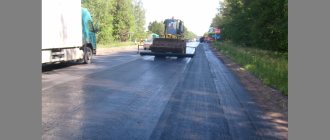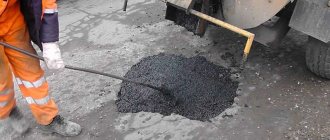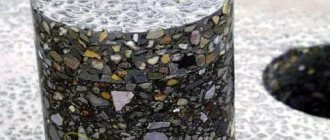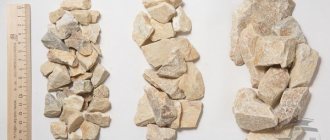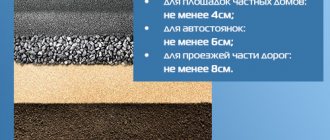Asphalt concrete pavement is a compacted layer of artificial building material consisting of mineral powder, aggregates and bitumen binder. The mixture has valuable properties that are used in laying roads, constructing runways, pedestrian communications, and landscape architecture.
The history of asphalt concrete pavements goes back a long way. The American Incas built magnificent roads from stones, pouring natural bitumen into the joints. The innovation came to Europe much later. Asphalt concrete replaced stone and wooden paving stones. Today it is the most common material for road construction.
Types and applications
GOST 9128-2013 classifies asphalt concrete into several types depending on the mineral filler:
- sandy;
- gravel;
- crushed stone.
Mixtures are made using hot or cold methods. In the first case, viscous or liquid bitumen is used, and the laying temperature is 110° and higher. For cold asphalt concrete, only liquid binder is used. Lay the coating at a temperature of 5°C.
Depending on the characteristics of the components, the following types of asphalt concrete mixtures are distinguished:
- Sandy asphalt concrete is made from aggregates with fractions up to 10 mm. The material has little resistance to wear. It is used for constructing sidewalks, bicycle or pedestrian paths, and children's playgrounds.
- Fine-grained asphalt concrete contains grains up to 20 mm in size. Used to cover streets, highways, and airfields. It is prone to plastic deformation and rutting, so it is modified with various additives.
- Coarse-grained asphalt concrete is used to form the lower layers of road pavements. It contains crushed stone or gravel up to 40 mm in size. Sand is added to fill the voids between large particles and increase density.
Dense crushed stone or gravel compositions correspond to the following types of asphalt concrete mixtures:
- A - mass fraction of coarse aggregate 50-60%;
- B - 40-50%;
- B - 30-40%.
Types G and D contain only sand from crushing screenings or natural origin; they do not contain crushed stone.
To increase strength and improve binding properties between components, cellulose stabilizers are added. The resulting material is called crushed stone-mastic asphalt concrete (SMA). For its manufacture, dense cubic-shaped rocks are used, which form a strong frame. Due to its resistance to deformation, SMA is used for the construction of heavily loaded roads.
Another type of coating with an organic binder is colored asphalt concrete. During production, the composition is tinted with pigments. Use clarified bitumen, marble or brick chips, crushed quartzite or granite.
Colored asphalt concrete pavements mark bicycle or pedestrian paths, cover sports and children's playgrounds, and decorate landscapes.
What is the minimum layer to be laid?
The resistance of the coating to loads depends on the thickness of the asphalt layer.
- On pedestrian paths, it is enough to lay asphalt, the thickness of which does not exceed 3-4 cm.
- Driveways in the courtyards of houses require a more serious approach and the creation of an asphalt covering with a thickness of 5-7 cm.
- Roads with heavy vehicle traffic have a coating whose thickness cannot be less than 7 cm.
All standards for asphalt laying technology are recorded in the GOST and SNiP documentation.
Composition and technical characteristics
The composition of asphalt concrete is multicomponent. It is selected and calculated based on the operating conditions of the coating, as well as available local materials.
Components
30-60% of the asphalt concrete mixture consists of crushed stone or gravel, which is obtained during the development of deposits of sedimentary or volcanic rocks, from metallurgical waste. The properties of the coating depend largely on the physical characteristics and shape of this coarse aggregate.
Sand is an essential component of asphalt concrete. It fills the voids between the stones, making the mixture more uniform and dense. The grain content is limited, since excess impairs the wear resistance of the coating. In addition to bulk material of natural origin, screenings from crushed stone or sedimentary rocks and ground slag are used.
Mineral powder makes up up to 20% of the mass of the asphalt concrete mixture. These are sedimentary or dolomite rocks crushed to dust, industrial waste, and ash slag from thermal power plants. They are used in non-activated or activated form. This increases the water resistance, strength and density of asphalt concrete.
The grade of bitumen is selected based on the climatic zone and the standard load on the road surface. The consumption of the petroleum product is 25-90 kg per ton of asphalt concrete mixture and depends on the porosity of the aggregates and the laying mode. To improve its performance properties, bitumen is modified with additives containing crumb rubber, recycled polyethylene, slaked lime and an adhesive composition.
Main technical characteristics
Depending on the properties and raw materials used, GOST distinguishes 3 grades of asphalt concrete:
- I includes hot high-density and dense types A, B, D, porous highly porous crushed stone, cold types Bx, Bx, Gx;
- Ko II - hot B, V, G, D, porous, highly porous sandy, cold Bx, Bx, Gx, Dx;
- to III - hot dense B, G, C, D.
The main physical and mechanical properties of asphalt concrete mixtures are determined by the brand, laying mode and temperature during testing:
- compressive strength - normalized for 0°C - 9-13 MPa, for 20°C - 2-2.5 MPa, 50°C - 0.9-1.5 MPa;
- density - 2000-2800 kg/m³;
- water resistance - 0.6-0.95;
- coefficient of internal friction (shear resistance) - 0.62-0.87;
- shear adhesion at t=50°C - 0.22-0.50 MPa;
- crack resistance - 2-7.5 MPa;
- water saturation - 1-4% for dense, 4-10% for porous;
- porosity for cold asphalt concrete mixtures - 18-21%;
- frost resistance F15-50 depending on the road-climatic zone.
The most important indicator is the compaction coefficient of the asphalt concrete pavement, which characterizes the quality of the laying. It is determined empirically. According to the standards, the value for cold compositions should not be less than 0.96, for hot ones - 0.99.
To measure the compaction coefficient of the mixture, cores are cut out in the pavement, dried, and the actual specific gravity of the asphalt concrete is determined. After heating, the samples are crushed and subjected to pressure treatment. The required parameter is defined as the ratio of the real density to the standard density obtained as a result of tests.
To calculate the consumption of asphalt concrete per 1 m² of pavement, use experimental indicators per 1 cm of height:
- fine-grained mixtures of types A, B, C - 24.6-25.7 kg;
- coarse-grained - 24.2 kg;
- ShMA - 25.8 kg;
- cast with a density of 1500 kg/m³ - 15.4 kg.
Cold way
The cold method began to be used not so long ago, but its convenience has already been appreciated by most road repair and construction companies. The use of a cold mixture allows the coating to be used immediately after installation, which is most convenient for urgent repairs in areas of busy road sections: intersections, large road junctions, in front of traffic lights. This road paving technology allows the mixture to be used in bad weather. Rain or snow will not interfere with the laying of cold asphalt. This mixture can also withstand strong temperature changes: from +50 to -25 degrees.
As you can see, neither severe frosts nor “hellish heat” will become an obstacle to high-quality road work. The cold mixture is simply stored in special packaging at room temperature. There is no need to carry out any manipulations with it; it is already ready for use. This material is used only for repair work. It is quite expensive. Unfortunately, its strength also leaves much to be desired, which is why cold mix is not used in the construction of highways and main roads. Although the characteristics of the material state that it can be laid at high temperatures, the strength of the coating suffers greatly in the summer.
What is the difference between asphalt and asphalt concrete?
Asphalt concrete mixture is an artificial material that is obtained by mixing solid ingredients with petroleum road bitumen.
Natural asphalt is formed in the process of thickening and oxidation of oil that has come to the surface of the earth in the form of reservoir deposits, individual veins or lakes.
The word “asphalt” translated from ancient Greek means mountain tar. It is a fusible black substance. The fracture is conchoidal, matte or shiny. Contains up to 70% petroleum bitumen.
The largest sources of natural asphalt are the Dead Sea in Israel and Peach Lake in Trinidad. The ancient Syrians mined hard bitumen, which floated to the surface in huge blocks, the weight of which reached 1000 kg.
Mountain resin was used for waterproofing ships, hut walls, granary floors, and for making paints or varnishes. In Ancient Egypt, the substance was used to embalm the dead.
Natural asphalt supplies are limited. Painting paints and paint products are made from high-quality raw materials. In road construction, when installing an asphalt concrete surface covering, part of the liquid bitumen is replaced with solid bitumen. At the same time, the resistance to the effects of studded tires is significantly increased.
Device technology
The asphalt concrete mixture may be of high quality, but if the technology was not followed during installation, the coating will quickly fail. When performing each stage of work, you must follow clear rules that are established by GOST R 54401-2011, 9128-2009, SNiP 3.06.03-85.
Preparation
Activities include the development of a technical project and the preparation of financial estimates. When planning, the object is tied to the terrain, providing for the possibility of removing wastewater and preserving above-ground and underground communications.
Before installing the asphalt concrete surface, large trees are cut down and the top fertile soil is removed. The higher the design load on the roadway, the greater the volume of excavation work that must be performed to create a foundation with sufficient load-bearing capacity. For garden paths and sidewalks, the layer height is 10-20 cm, for loaded roads - up to several meters.
To prevent water from stagnating under the asphalt concrete road, drainage is organized. The soil is transported outside the territory to avoid clogging the drainage system in the event of erosion.
Pillow device
The function of the cushion is to absorb compressive loads during the operation of asphalt concrete surfaces. Its thickness is determined by calculation. First, large fractions up to 60 mm are laid, then medium ones 20-40 mm, sand on top with obligatory compaction of each layer.
In private construction, various construction waste is used for backfilling, which is much more economical than crushed stone or gravel. Curbs or other durable materials are laid along the edges of the asphalt concrete road.
Laying asphalt concrete
Work is carried out in dry weather at a temperature not lower than 5°C. Depending on the type of asphalt concrete mixtures, the following technologies are used:
- The cold mixture is laid on a prepared base, preferably spilled with bitumen, in a layer of up to 5 cm. Compacted with a manual tamper or vibrating plate. Cement or sand is sprinkled on top to reduce the stickiness of the road surface.
- Hot asphalt concrete is made from molten bitumen and aggregates, thoroughly mixed and laid on the base. The mass is rolled or compacted. Operation is permitted after 6 hours.
- Cast asphalt is laid very hot - up to 235°C. It is fed from the kocher, which heats and mixes the mixture, into the hopper of the asphalt paver. After uniform distribution over the surface, the composite cools and hardens. No compacting or rolling is required.
The influence of asphalt mixture temperature on the compaction process
The efforts used for technologically competent asphalting depend on the degree of heating of the mixture. I begin compacting the surface when the asphalt layer has cooled slightly, but has not dropped below 80 degrees. The preliminary procedure is carried out by an asphalt paver. Initial compaction is necessary to create a perfectly smooth asphalt. Heavy rollers can disrupt the integrity of the hot coating and displace layers of material.
First, the rollers are driven over the laid asphalt without vibration. The degree of compaction is checked using automated systems.
The lower the temperature of the bitumen included as a binding element in the mixture, the more difficult the installation process will be. When working with a hot mixture, bitumen acts as a lubricant, reducing friction between the road surface and the rollers of the roller.

